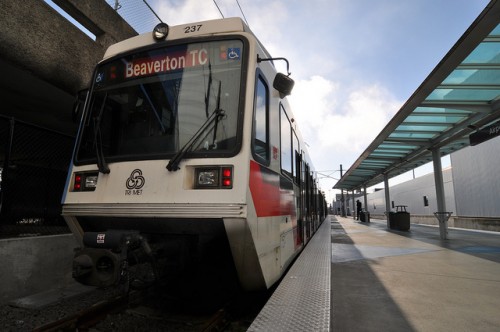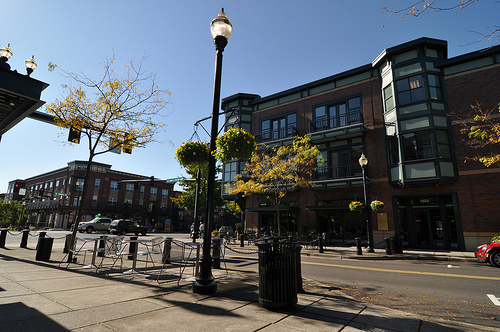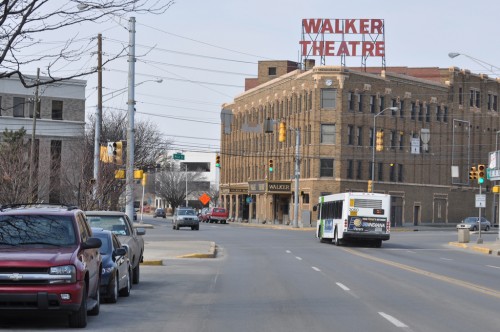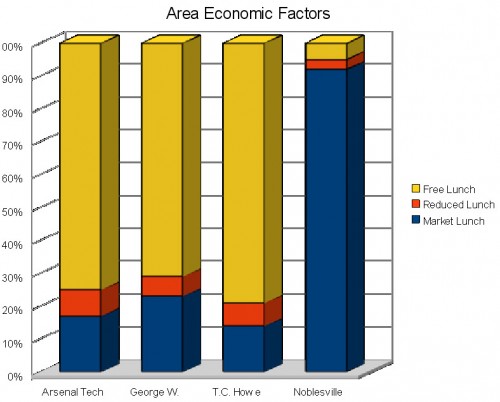Â

When does perception become reality? When a preconceived notion trumps all logic and becomes the first thought associated with a specific topic. Why is it then, that “light rail” seems to be the favored quarter when it comes to alternative transportation modes?  Last week, I tackled the first half of why we perceive light rail to be superior to commuter rail when I wrote about, “Why Route Matters for Indianapolis”. In that post, I highlighted that it isn’t neccesarily the mode that gets you there, but where a transit route goes that drives ridership gains.Â
So…. why light rail?
If we base our decision on the facts alone, we can determine that LRT offers advantages. Service frequency, ease of use and closer station spacing all combine to create a propensity to choose LRT over all other modes when given a choice. Additionally, when compared to a bus, statistics have shown that LRT draws more riders than comparable bus service. Furthermore, one of the advertised benefits of LRT over bus, is that it’s static locating of rails in the ground promote incentive for private developers to build near station areas. This type of development (often called Transit Oriented Development or TOD) typically offers a denser living environment due to it’s lessened need for automobile parking. Private development within urban areas is a KEY economic development opportunity and often one of the main political reasons for choosing “light rail” over all other modes of transit. Another perception and a hard one to battle, is that LRT technology is new. The compact nature of LRT operating within urban environments creates the image of an efficient and “fun” mode of transportation to utilize.

Why NOT bus?
The bus’ main competition is the automobile since they both share the same right of way. Given a choice, statistics show that people would rather drive than use a bus. Case in point. IndyGO recently released their 2010 year in review. In the report, they indicated that 116k people rode the IndyGO Express lines last year. To contrast this, I searched the Indianapolis MPO website for their traffic count maps. I zeroed in on the stretch of I-69 that was measured between 82nd street & 96th street; a comparable geographic region for where the IndyGO Express line services. The count? As of 2002, 107k traffic counts. PER DAY. Similar ratios can also be observed by comparing daily IndyGO city bus numbers with daily traffic counts in the urban core. The bottom line is that people are voting with their choice in mode of transportation. Additionally, I cannot cite one development in the Indianapolis region that was chosen because it was located along a bus line. Of course developers will mention the route’s precense, but it is highly unlikely that a route was a primary factor in locating a property development.

Why or why not commuter rail?
Basically, this boils down to level of service. Commuter rail typically provides a quality of service similar to light rail, but a frequency that makes it difficult to utilize. The example set by other cities can provide a picture of what we might expect from commuter rail service in Indianapolis. Portland’s WES (Westside express Service) runs every 30 minutes during rush hour on weekdays. WES provided an average of 1180 daily rides in December of 2010. Minneapolis’ Northstar, according to the website, only offers 6 inbound trips per weekday, 1 of them in the afternoon, and those in the morning are close to every 30 minutes. There is service on the weekends, but it is greatly reduced. Northstar carried 710,400, an average of 1946 per day in 2010, it’s first year of revenue service.  Even in Chicago, METRA, which could be considered a service leader in midwest commuter rail service, offers a sporadic level of frequency on it’s electric line (south). Unless planners consider offering better service for the commuter routes in Indianapolis, 30 minute headways could be reasonably expected.
Regarding Private Development
Perhaps the greatest measuring stick, is when a politician can get up in front of a group of his peers, local or foreign, and tout the benefits of living in their city. Regarding transit investment, the first place that comes to my mind is Portland and their streetcar. According to the latest data that I have seen, the downtown Portland area has benefited from $3.5 billion in economic development in the form of condos, retail, etc within 2 blocks of their streetcar route. The leaders in Portland point to the streetcar as the single biggest motivator for rehabilitating an entire district, now called The Pearl. If I could point out a case that clearly makes the case for frequent rail service as an economic driver, this would be it. The development did not result from a bus, nor was it low frequency commuter rail. It was light rail/streetcar type of service that created a perception that there was an opportunity for private business to invest in the community. Obviously, Portland’s civic leaders grabbed onto this opportunity and the ride continues to this day.

Circling back to Indianapolis, one of the key reasons for Indyconnect’s existence, is that it is will give people in the region another tool to create wealth. This can come in the form of equitable travel to employment, activity centers or property development areas around stations. This is not a bad thing if the creation of that wealth generally benefits everyone using it. So what if some developers make some money…. we get a good transit system to use right? At it’s core, providing these opportunities has the chance to increase the quality of life for people who choose to indulge in said opportunities. It is for this reason, why arguing for “light rail” is a valid topic of debate and also why route matters. One last thought to close on this matter. Fellow Urban Indy writer Graeme Sharpe recently put together the above graph, depicting the amount of subsidized lunches that are provided to some area schools. This is one possible barometer of the economy present in those geographic areas. Put plainly, Noblesville HS is closely aligned with the NE Corridor while the other 3 are located along the Washington St corridor.
If we are trying to create economic development options, are we doing so in the right places? You decide….
Post Script…
If I have leaned a little too much on Portland for some of the conclusions, it is for good reason. The recent census figures pegged their growth at 10% over the last 10 years with a glut of that occuring in the inner core. Furthermore, TriMET provided nearly 100 million boardings in 2010 compared to 8.5 million in Indy. For a city that is comparable in a number of way, it is hard not to use their example to frame our story.
Nice post.
.
Actually, Curt, one of the primary “hurdle” factors in choosing the Pogue’s Run Grocer location was bus service. But what do you expect from a bunch of community-development folks? 🙂
I totally agree with all of the benefits mentioned with LRT…especially the TOD opportunities and the ease of ridership. Indianapolis Bus service will never contribute to these two attributes—since density is a necessary ingredient.
Certainly LRT is the “hot” option, but what to the effect of BRT in Curitiba, Brazil? The entire city has shaped itself along BRT corridors. This model is extremely efficient and cost effective and The development along the routes is beyond description.
It might not be easy to compare Curitiba and Indianapolis. Brazil has a growing middle class, but having a car is still a luxury for a lot of people. Once more people can afford driving, they tend to choose to drive over riding a bus. However, LRT is much more resistant to such factors.
But at what cost? BRT is phenominaly more flexible for a fraction of the cost. We could take a portion of projected savings, invest into an interest gaining account to then fund the system or provide subsidies that make it much cheaper than a car. After poeple get familiar with the process they may be more likely to continue if price should increase. This will be especially true with increases in parking fees. A lot of the shadow cast on busses is unfamiliarity and uncertainty.
Here is my issue with BRT. Bus Rapid Transit as it is captured in the Indyconnect plan, is NOT investment. It is a few prettied up stops here and there where the buses will still operate in the same fashion as an automobile would. They may get some lanes here and there, and some traffic signal priority. But there will be no dedicated busway. There will be no new big investment that shows we are making a long term dedicated effort to this.
If dedicated lanes were going to be planned, I might get on board with that idea, but then if that is the case, it is going to approach similar costs as light rail would. And light rail vehicles last a lot longer than buses do…. even if their initial investment is a bit more.
I do agree that the plan will provide anything but Rapid bus transit. I have argued with some in charge about this. My comments are simply geared towards the general idea of BRT.
I like BRT… for the rest of the bus system. Ideally, baseline bus service in any dense urban area ought to resemble various levels of BRT, with things like signal priority, queue jump lanes, low-floor vehicles, and all-door boarding. Obviously, these things are expensive to build out, but in much of Europe, this is what the baseline bus service looks like.
In really dense/congested areas, dedicated lanes ought to be standard. Portland does this with the transit mall, and works well–what we don’t do in PDX is brand the thing as “BRT”; it’s simply part of the bus system.
When you get to building a dedicated long transit corridor, the arguments for rail get stronger. BRT is a good compromise option for when you can do partial exclusive lane but not full exclusive lane; as busses operate better in mixed traffic. But if a vehicle is going to get a dedicated ROW for the length of its run, making that vehicle a train frequently is a wise investment.
I just have to disagree with EngineerScotty. Yes, all of the buses in the system need a serious image upgrade as well as service upgrade, but BRT needs to be a mainline only system. What would you rather have: A pretty little LRT line(or two) through desolate neighborhoods that may take years to develop into anything walkable or a BRT SYSTEM with upgraded circulator bus routes and extra funding to improve walkability and/or Complete Streets concepts?
Even over long-haul, the cost of implementing LRT over BRT is substantial, and BRT is so much more flexible it’s crazy. Slight tweaks in routes and changes in frequency or even capacity are simple and cheap to make. Standardizing station/stop design could lower the cost for those substantially. I fully believe that the city could privatize IndyGo as a non-profit corporation and put the next year’s operating expenses into an account and the new organization could implement this sort of system within two years and be completely revenue-neutral within five years.
“completely revenue-neutral within five years”
Extraordinary claims require extraordinary evidence.
Thanks for the reply Graeme, these are indeed extraordinary claims. And I have a great amount of fault for not fully laying out what I think could and should be done to achieve this. I would like to work on my proposal in the next couple of weeks. But let me flesh out a few ideas.
Anyone who has read The Indypendent(not many admittedly, as it hasn’t been updated in two years almost) will know that I like to see the private sector and civil society step up to solve societal problems. Keep this in mind. My basic idea is a complete revamp of IndyGo – brand, marketing, vehicles, executives, routes, pricing, stops, everything.
– The city would spin off the department as a private not-for-profit corporation that would be gifted with all of IndyGo’s assets, one year’s operating and capital expenses, and title to all city seized(through tax lein and abandonment) properties directly along the new system’s ROW.
– It would be free to retain only the personnel they wanted and use what labor practices they believed were most sustainable and practical.
– The new corporation would implement a new system with 12 new BRT lines, and 64 circulator lines.
– Of course, new branding on all the buses, and older vehicles will be sold off and replaced.
– New seating with lower capacity but higher amenities. Lower headways allow for this
– New standardized stop and station design that are clean, low maintenance, self sustaining, and safe. All will protect riders from rain.
– Corporation will be able to land-lease properties bestowed upon them for TOD projects meeting pre-determined design guidelines.
– First city in the world to implement self-driven BRTs on separate busways with total signal prioritization.
– Fares based on entry to system and capacity pricing.
– As part of deal, city commits all formerly transit-related spending to Complete Streets upgrades to major thoroughfares and sidewalk repair and/or installation to all neighborhood streets on an accelerated timeline.
– Any surplus revenue is given back to city fund for improved neighborhood lighting.
Obviously there is a lot here and probably something that has a 0.002% chance of implementation, but everything together could lead to a flexible and adaptive transit corporation providing innovative transportation services to the populace and a city of Indianapolis with more funds available to enhance livability in the urban core. Hopefully a virtuous cycle ensues and tax revenue sees a spike and the city can pay down outstanding debts.
I think anyone who reads this will wonder “What is the difference between gifting all these public assets to the new corporation versus charging a tax on service area?” Also, I’m sure transportation experts would have a few more questions such as: who is paying for the commitment to thoroughfare improvements, building new shelters, leading the effort for driverless BRT, the costs of Paratransit service and unpopular service routes, and creating separated busways? Are these all going to be gifts from public treasury to a private company?
What issues are you trying to solve by making the corporation private? Privatization is not a slam dunk, and the concept that private companies are always better than public services is definitely hurting your proposal. As a thought exercise, try to envision a blended entity that is directly funded and controlled by “We the People” but uses market techniques to manage supply & demand better than central planning. Don’t just rely on lazy ideologies that basically equate “public = bad” & “private = good.”
Finally, we need to see you run the numbers. Give us a compelling financial argument for why your ideas are better our current system and the IndyConnect proposal. We need more than just a shopping list, we need evidence you know what you are talking about.